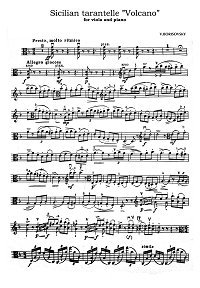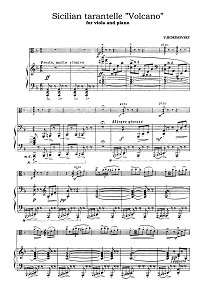|
Borisovsky - Sicilian Tarantella "Volcano" for viola and piano |
Borisovsky - Sicilian Tarantella "Volcano" for viola and piano
Borisovsky - Sicilian Tarantella "Volcano" for viola and piano. You can download the PDF sheet music Borisovsky - Sicilian Tarantella "Volcano" for viola and piano on this page. The founder of the Soviet school of viola playing, Vadim Borisovsky, professor of Moscow Conservatory, devoted his entire life (1900—1972) to achieving a rebirth of the viola as a full-fledged concert instrument. An impeccable sense of style and a refined artistic taste are, perhaps, the principal features of Borisovsky's interpretative art. His gift of carrying the audience with him along was intimately linked to his rare skill in capturing the entire form of a composition and relating the whole and its details. Added to this was a deep and delicate lyricism as well as his skilfully moulded musical phrasing, complemented by an unpremeditated rubato. In this remarkable piece – Sicilian tarantella “Volcano“, Borisovsky achieved an ideal concordance between music and its actual expression in his interpretation of works of most diverse genres and periods.
To download PDF, click the "Download PDF" button below the appropriate sheet music image.
To view the first page of Borisovsky - Sicilian Tarantella "Volcano" for viola and piano click the music sheet image. |
| PDF format sheet music |
|
|
|
Instrument part: 2 pages. 1372 K
|
Piano part: 6 pages. 4461 K
|
 |
 |
| +++ |
+++ |
| Download PDF (14.99
€) |
Download PDF (14.99
€) |
|
The idea of giving the viola the same solo-instrument rights as those enjoyed by the violin and cello was still bold, even excessively so in the early 1920s when Borisovsky embarked on his artistic career. The general level of viola playing was low, and no Russian conservatory offered special training for viola instrumentalists; perhaps, the only serious Russian musician working in this field was Vladimir Bakaleinikov, Borisovsky's teacher. Hence, Borisovsky and his numerous students took it upon themselves to train viola players and teachers, collect an extensive and diverse instructional and concert viola literature, and to enrich the viola technique — tasks they accomplished excellently.
«The artistic and creative merits of this remarkable musician,» Shostakovich wrote of Borisovsky, «can serve as a model to our young instrumentalists. He was not only a fine artist, but a musician of high culture as well. I always felt happy when he took part in the performance of my work».
The viola d'amore figured prominently in the musician's versatile creative endeavours. He mastered the instrument by himself in 1926, and in 1927 was already giving recitals in Moscow and Leningrad. Its warm timbre, so much resembling the human voice, and the clear melodiousness were what primarily attracted Borisovsky to the viola d'amore. Borisovsky became a viola d'amore enthusiast as performer, teacher, and author of many transcriptions and editions.
|
|